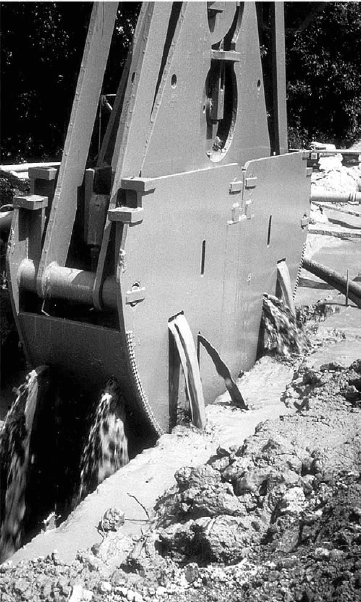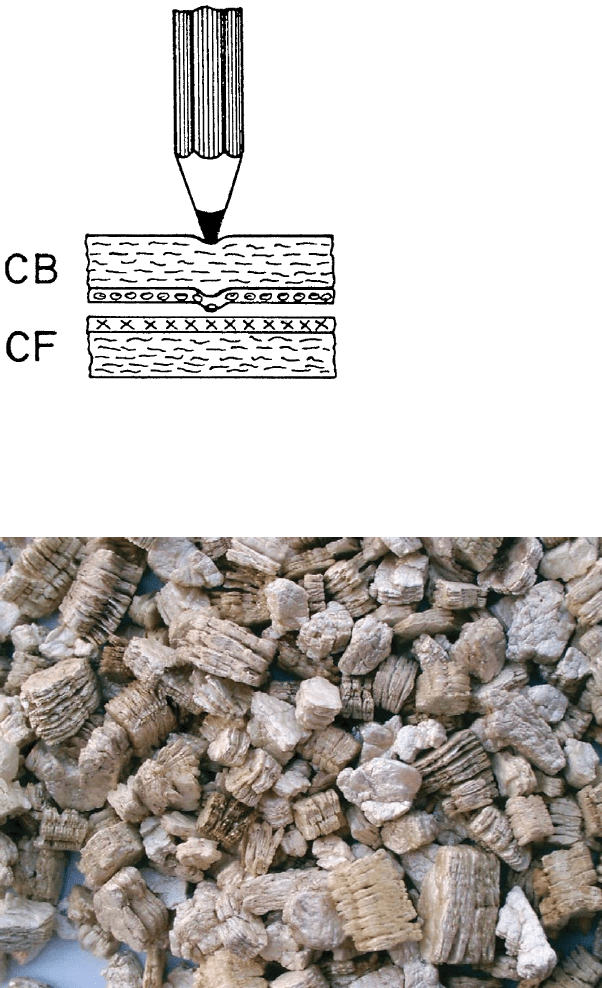Bergaya F. Handbook of Clay Science
Подождите немного. Документ загружается.


catalyst supports, water purification, fertilizers, ceramics and other miscellaneous
applications such as additives in washing powders, for newspaper recycling, cleaning
waste water from car washes and as flocculation aids, often together with soluble
flocculating agents such as polyions, alum (aluminium sulphate) and iron chloride
(Table 10.1.2a, b and 10.1.3)(Grim, 1962; Odom, 1984; Fahn and Schall, 1985;
Schall, 1988; Murray, 1986, 1999, 2000; Harvey and Murray, 1997; Caine et al.,
1999; Panpanit and Vi svanathan, 2001; Philippakopoulou et al., 2003).
Bentonite as Binding Agents
Bentonites are extensively used as binding agents in the pelletization of iron ore,
other fine-grained solids and animal feed. The sands are prepared with about 2%
bentonite. The montmorillon ite layers ensure adhesion between the particles in a
similar way as described for moulding sands (see below). Natural sodium and so-
dium-exchanged calcium bentonites are preferred for iron ore pelletising because of
their high capacity for removing excess water from the powdered ore. In other cases,
both sodium and calcium bentonites are used. Bentonite added to animal feeds can
increase their nutritional benefit.
In foundry moulding sands the clay mineral pa rticles have to make the sand
plastic and cohesive so that the sand can be moulded around a pattern. The bento-
nite also gives the sand sufficient strength to resist the thermal stress of the molten
metal. Green compression strength, dry compression strength, wet tensile strength,
hot compression strength, flowability and durability (clay-bonded moulding sands
are recycled many times) are crucial properties in foundry usage. Again, the Na
+
/
Ca
2+
ratio is very important to adjusting these properties (Odom, 1984). Natural
sodium bentonites have better durability and higher fusion temperature and are
favoured for use in steel foundries. Bentonites containing Ca
2+
ions are preferred for
preparing moulds for iron casting. Many foundries use specified blends of specific
types of sodium and calcium smectites to achieve the optimum moulding sand
properties.
Table 10.1.2a. Uses of clay minerals based on their rheological properties
Clay family Industry Uses
Common clays Ceramics Tiles, bricks, earthenware,
stoneware, sewer pipes, sanitary
ware, refractory bricks
Kaolins Paper Coating
Ceramics Porcelain, bone china, vitreous
sanitary ware, earthenware
Bentonites See Table 10.1.2b
Palygorskite, sepiolite Paints, chemical and
mineral oil industry
Thickening and thixotropic
additive, dispersing and anti-settling
agent, drilling fluids
Chapter 10.1: Conventional Applications508

The importance of having sodium ions in the interlayer space was described by
Hofmann and Endell (1935, 1936). Adding soda ash (Na
2
CO
3
) to German bentonites
that are not suited for foundry-moulding sands should be made such clays suitable
for use as a moulding sand binder.
Bentonite in Drilling Muds
Oil well drilling fluids are colloidal dispersions of complex composition (van Olphen,
1977; Odom, 1984; Darley and Gray, 1991). First of all, the fluid acts as a lubricant
to reduce the friction between the drilling string and the side of the hole. The drilling
fluid is circulated to bring the drill cuttings from beneath the bit up to the separation
site and to cool the bit. Therefore, drilling fluids must have a relatively high density
to carry the fine cuttings. The drilling fluid builds up an impermeable filter cake of
smectite (montmorillonite) particles on the side of the hole, preventing the loss of
fluid into the permeable rock (see Chapter 5). It also prevents the inflow of fluids (oil,
gas, or water) from permeable rocks. When the drilling operation is interrupted
Table 10.1.2b. Uses of bentonites based on their rheological properties
Area of
applications
Uses Activation
Agriculture,
horticulture
Soil improvement r, s
Building industry Supporting dispersions for cut-off diaphragma
wall constructions, shield tunneling, subsoil
sealing, antifriction agents for pipejacking and
shaft sinking additions to concrete and mortar
r, s
r, s
Ceramics Plasticising of organic masses, improvement of
strength, fluxing agents
r, a
Foundries Binding agents for moulding and core sands r, s
binding agents for anhydrous casting sands o
thickening of blackwashes o
Mineral oil industry Drilling fluids r, a, o
thickening of greases o
Paints, varnishes Thickening, thixotroping, stabilising, anti-settling
agents
s, o
coating materials, sealing cement, additives for
waxes and adhesives
s, o
Pharmaceutical
industry, cosmetics
Bases of creams, ointments and cosmetics r, a, s
Stabilisation of emulsions r, o
Tar exploitation Emulsification and thixotroping of tar-water
emulsions, tar and asphalt coatings, additives for
bitumen
a, o
r: raw bentonite, a: acid-activated bentonite, s: soda-activated bentonite, o: organo-bentonite.
10.1.1. Industrial Uses 509

Table 10.1.3. Uses of clay minerals based on their adsorption properties and reactivity
Clay family Industry Uses Activation
Kaolin Fibre glass Source of alumina
Petrochemicals Catalyst support
Chemical industry Zeolite synthesis
Building industry Additive in cement
Bentonite Agriculture,
horticulture
Soil improvement, composting r, s
adsorption of mycotoxins o
Chemical industry Sulphur production: refining,
decolouration, bitumen extraction
r, a
Catalysts r, a, s
Carriers for pesticides r, a, s, o
Dehydrating agents r, a, s
Adsorbents for radioactive materials r, a, s, o
Cleaning industry Regeneration of organic fluids for dry
cleaning
a
Polish and dressings r, s
Additives for washing and cleaning agents
and soap production
r, s
Environmental
technology
Forest and water conservation: fire
extinguishing powders, binding agents for
oil on water
r, a
Animal husbandry, manure treatment, cat
litter
r, s
Water and waste water purification r, s, a
Sewage sludge pelletizing r, a
Barriers r, s
Food stuff
industry
Refining, decolouration and stabilization
of vegetable and animal oils and fats
r, a
Fining of wine, juices, beer stabilisation,
purification of saccharine juice and syrup
r, a, s
Mineral oil
industry
Refining, decolouration, purification and
stabilization of mineral oils, fats, waxes
and paraffins
r, a
Paper making Pigment and colour developer for
carbonless copying paper
a
Adsorption of impurities in circulation
water
r, a, s
De-inking in waste-paper recycling r, a, s
Cosmetics,
pharmaceutics
Powders, tablets, drug carrier, odour
control, liquid absorption
r, a, s, o
Palygorskite,
sepiolite
Chemical industry Adsorbent,
carrier,
bleaching,
decolouration, anti-caking agent
Environment Cigarette filters (sepiolite), cat box litter
r: raw bentonite, a: acid-activated bentonite, s: soda-activated bentonite, o: organo-bentonite.
Chapter 10.1: Conventional Applications510
before the drill cuttings and sand were circulated out of the hole, the thixotropic
stiffening (see Chapter 5) of the drilling fluid prevents settling of the fine material. In
offshore drilling or drilling through salt domes the fluid must be protected against
destabilization by salts.
Drilling fluids are mainly based on dispersed sodium bentonites. The particular
requirements can only be fulfilled by components whose properties may in some
cases be counteractive. For instance, the thixotropic property of the fluid requires
conditions that are adverse to optimal plastering. When calcium and/or barium
sulphate are added to enhance the density, or calcium and barium hydroxide are
added to reduce the large increase of viscosity at the high temperatures in deeper
holes, the divalent cations would cause coagulation of the dispersed particles. This
effect is usually overcome by the addition of complexing macromolecular com-
pounds that also impart a high degree of steric stabilization. A well-known additive
is carboxymethyl cellulose (cf. Fig. 5.22). Other macromolecular compounds such as
polyphosphates are less effective as steric stabilizers but they improve the salt sta-
bility by reversing the edges of the clay mineral particles from positive to negative, or
increasing the negative edge charge density. The common Quebracho tannates in the
red muds exert both effects (see Chapter 5).
Bentonite in Engineering
Bentonite dispersions are used in many civil engineering applications. Most impressive
is the diaphragm-walling technique. A thixotropic bentonite dispersion is used as an
intermediate supporting material, obviating the need for revetting (retaining wall)
when the trench is excavated. In addition, the plastering effect (see Chapter 5) is
important. The slurry penetrates only to some extent into the trench sides and forms an
impermeable filter cake of clay mineral layers on the walls so that excessive loss of fluid
to the surrounding formation is prevented. In the next step, the bentonite dispersion is
displaced by the concrete (Fig. 10.1.5). Concrete walls about 100 m deep and 0.8–1.5 m
thick are built up by this technique. (It is interesting to note that the stabilizing effect of
bentonite dispersions was observed in the middle of the 19th century. The first patent
was issued in 1912 but the technique was only widely applied since about 1950.)
In other applications bentonite dispersions are used to grout cracks and fissures in
rocks, for soil injection, or to impede water and waste-water movement through
soils, sand, or gravel. Examples are sealing waste deposits (see Chapter 11.3), sewage
ponds or ornamental ponds. The dispersions are used as lubricants not only in
drilling fluids but also to lubricate caissons (Fig. 10.1.6) and piles or cables as well as
pipes for pulling through conduit. In shield tunnelling the thixotropic bentonite
supports the soil in front of the shield until it is removed by the tools of the rotating
shield. It also has to keep back ground water, and transport the excavated soil to a
separation plant above ground.
Bentonite can be added to waterproof concrete walls and floors, or added to
mortar to increase its plasticity (see also (Krøyer et al., 2003)). Bentonite also serves
as an important additive in bitumen emu lsions.
10.1.1. Industrial Uses 511

The properties of bentonite that are most significant in the above-mentioned civi l
engineering applications are viscosity, yield value, thixotropy, plastering ability and
plasticity. Thus, only natural sodium bentonites and certain sodium-exchanged cal-
cium (magnesium) bentonites are suited for the purpose.
Bentonite as a Thickener
Bentonites are added to paints and enamel paints not only as thickening agents and
gellants but also to impart a certain degree of thixotropy to the dispersion and so
impedes sagging of the paints (Jones, 1983)(Fig. 10.1.7). In non-polar systems the
clay mineral particles have to be hydrophobized (see Chapter 7.3).
Activated Bentonites, Fuller’s Earth and Catalysis
A large diversity of applications are related to the adsorption capacity and chemical
reactivity of bentonites (Table 10.1.3). Their ability to adsorb proteins and high-molecular
Fig. 10.1.5. Diaphragma walling. Excavation of a trench and its subsequent lining with a
thixotropic bentonite slurry.
Chapter 10.1: Conventional Applications512

compounds (see Chapters 5 and 7.3) is useful for stabilizing beer,
4
and improving the
taste and quality of juices and even cheap wines (Rankine, 1995; Sarmento et al., 2000).
An up-coming important application is the use of modified bentonites as adsorbent of
mycotoxins. These excretions of certain moulds on cereal grains and oil seeds are
extremely toxic and enter the food chain of both animals and humans.
Most important is the use of acid-activated bentonit es (‘bleaching earths’, see
Chapter 7.1) for decolourizing vegetable and mineral oils (Fahn, 1963, 1973; Sarier
and Gu
¨
ler, 1988; Srasra et al., 1989; Jovanovic
´
and Janac
´
kovic
´
, 1991 ; Mokaya et al.,
1994; Theng and Wells, 1995; Erdog
˘
an et al., 1996; Ravichandran and Sivasankar,
1997; Christidis et al., 1997, 2003 ; Falaras et al., 1999, 2000; Jozefaciuk and
Bowanko, 2002). The removal of pigments not only decolourizes vegetable oils but
also improves taste and stability.
Fuller’s earth were used for centuries to remove fat from animal wool (‘fulling’), and
is a mixture of different clay minerals (palygorskite, sepiolite, smectites). The compo-
sition of fuller’s earth varies between different localities. Fuller’s earth was used for oil
refining before the industrial production of acid-activated bentonites. The history of
fuller’s earths was described by Robertson (1986) and Beneke and Lagaly (2002).
Clays are used as catalysts and catalyst supports in many organic syntheses.
Montmorillonite is the most important clay mineral for these uses. The acid forms
bentonite dispersion
as lubricant
caisson
cutting
Fig. 10.1.6. During caisson sinking and pipe checking a highly viscous bentonite slurry re-
duces the friction between building structure and soil (outer light-shaded piece). Shown is the
cutting face of the caisson to be sunk or the pipe to be checked.
4
When the proteins are not removed from beer, their decomposition makes the beer undrinkable.
10.1.1. Industrial Uses 513

can provide environmental friendly alternatives to liquid Brønsted acids. ‘Clayfen’
and ‘Claycop’ are not catalysts but useful montmorillonite-supported reagents (see
Chapter 10.2).
Carbonless copying papers are composed of paper sheets with different coatings
on the back of the upper sheet (CB) and on the front of the lower sheet (CF)
(Fig. 10.1.8). CB is coated with micro-capsules (1–10 mm) of gelatine or poly-
urethane. The capsules contain a solution of leuco dyes, commonly crystal violet
lactone or N-benzoyl leuco methylene blue. CF is covered with a coating colour
consisting of an acid-activated bentonite (adjusted to pH 9–10) together with water
and binders. The pressure of a pencil or the stroke of a typewriter breaks the micro-
capsules at the point of contact. As the solution is released, the dye is adsorbed on
the coating colour of the CF front page, and the colour (crystal violet or methylene
blue) develops at this point ( Fahn and Fenderl, 1983).
D. Vermiculites and Micas
Vermiculites are commonly used in the form of expanded particles as shown in
Fig. 10.1.9 (see Chapter 7.2). The vermiculite flakes are expanded by rapid heating
from 250 to 1500 1C followed by immediate cooling to 400 1C. The evaporating water
Fig. 10.1.7. Addition of a thixotropic agent impedes sagging of the paints. From Lagaly et al.
(1997).
Chapter 10.1: Conventional Applications514

Fig. 10.1.8. Carbonless copying paper. The back of the upper sheet is coated with micro-
capsules containing the leuco dye, the front of the lower sheet is coated with an acid-activated
bentonite. From Fahn and Fenderl (1983).
Fig. 10.1.9. Shock-heated expanded vermiculite flakes (Courtesy K. Beneke, University Kiel).
10.1.1. Industrial Uses 515

expands the particles in worm-like (vermiform) manner (Grim, 1968; Bergaya et al.,
2001) and increases the volume by up to 1500 times. Extremely short heating periods
are required to avoid the decomposition of structural OH groups (Klose, 1982).
Expanded vermiculite is used in the building industry for heat insulation and sound
dissipation. In the packaging industry it is used as a thermal protecting and shock-
proof-filling material for glass containers and vessels. The high liquid absorption
capacity of expanded vermiculite reduces damage by breaking containers. In metal-
lurgy the surface of molten metals is covered with vermiculite for thermal protection.
Wet or dry finely ground micas, typically with a particle size similar to that of
filler clays, are found in heat-stable, UV-stable and under-water paints. Nacreous
(pearlescent) pigments (‘Perlglanzpigmente’), especially used in cosmetics, obtain
their exceptional optical properties from parallel oriented mica particles. Ground
micas are also used in corrosio n-proof materials, polymer coatings, underseal and as
an insulating material.
E. Talc and Pyrophyllite
Talc and pyrophyllite are important filler materials for polymer and rubber. Talc is
also used extensively in cosmetic and pharmaceutical powders. In pharmaceutical
technology talc is needed as an indispensable slip additive.
F. Palygorskite and Sepiolite
Sepiolite is used as a filler (cosmetics, polyester), a carrier (insecticides, herbicides,
catalysts) and as filter material and anti-caking agent. It is also used as a dispersing,
antisettling, thickening and thixotropic additive in paints and drilling fluids. The
thickening effect mainly results from the fibrous shape of the particles, and hence is
much less dependent on salt concentration and cations present than is the case with
bentonites. Palygorskite
5
is used in similar app lications. Sepiolite is further used as
adsorbent, for instance in cigarette filters, and as a decolourant, sometimes after
acid-activation (see Chapter 7.1). Sepiolite in the form of ‘meerschaum’ is also made
into pieces of jewellery and pipe bowls (Galan, 1996 ; Harvey and Murray, 1997).
G. Industrial uses of Mixtures of Clay Types
It is not unusual for single industrial users to utilise clays for both their inertness and
reactivity. For example, in many ceramic applications kaolins may be used as an
inert filler, while the reactive properties of bentonites or ball clays impart plasticity,
unfired strength and perhaps critical fired properties.
Combinations of clay minerals, such as kaolinite, smectite, talc and palygorskite
have long been in the preparation of pastes, ointments and lotions for external use.
5
Technical reports still use the older term ‘attapulgite’.
Chapter 10.1: Conventional Applications516

Cosmetic formulations also take advantage of the softness, dispersing, gelling,
emulsifying and adsorption properties of clays. Talc is the basis of cosmetic and
pharmaceutical powders, often combined with kaolins, bentonites and starch.
Solid particles, in particular combinations of bentonite and layered double hy-
droxides, are excellent stabilizers of emulsions. The important advantage is that such
emulsions can remain stable in the absence of any organic surface-active agents
(Abend et al., 1998; Lagaly et al., 1999a, 1999b; Abend and Lagaly, 2001).
Certain clays show a soapy appearance and, in fact, can be used for cleaning.
6
In
Europe, soap-like materials containing high amounts of clays were used during the world
wars and some time after. Clays were also used as shampoos, and not only by primitive
people (Mahjoory, 1996). Actually, clay minerals find increasing use in hair cosmetics.
Eating earth or clay is widespread throughout the world. Clays were used for centuries in
therapeutic, intestinal and adsorbent preparations (see Chapters 11.5 and 11.6).
10.1.2. PROCESSING INDUSTRIAL CLAYS
A. Purification and Fractionation
In most cases, relatively simple techni ques are used to investigate the properties of
clay mineral dispersions. Clay minerals having a certain degree of purity are sep-
arated from the non-clay minerals by sedimentation techniques. Particle size frac-
tionation is necessary to separate the clay minerals from associ ated minerals and
phases (see Chapter 1). Dry separation processes are effective down to sizes of about
7 mm. However, wet processing is necessary for finer particle sizes or for raw ma-
terials requiring chemical treatment for such processes as chemical bleaching or
magnetic separation. In wet pro cessing, a decisive step preceding sedimentation is the
preparation of a stabl e dispersion of the clay by replacing the divalent compensating
(charge-balancing) cations with sodium ions. The pH of the dispersion must be
maintained at 7–8 because the clay mineral particles aggregate at pH o6.5. The
stable dispersion of the clay minerals in homoionic form may then be fractionated by
gravity sedimentation, or for particle sizes below 1 mm this is usually done by cen-
trifugation (see Chapters 4 and 5).
Naturally occurring clays are typically mixtures of clay minerals and non-clay
minerals. Such clays may be cemented by metal hydr(oxides) or carbonates. Before
any processing flow sheet can be designed it is recommended that the clay materials
be disaggregated, the cements removed and the clay particles dispersed.
It is important to understand the nature of the cements and the composition of
the total material, so that any process ing flow sheet can be designed to remove the
non-clay minerals. The following processes may be involved: (i) purification; (ii) wet
versus dry pr ocessing; (iii) parti cle size separation (fractionation); (iv) bleaching and
6
Saponite is derived from Latin sapo, meaning soap (Grim, 1968; Bergaya et al., 2001).
10.1.2. Processing Industrial Clays 517
